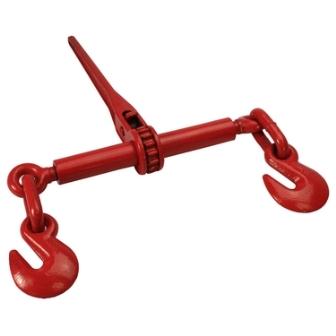
Chain Binders
What is a Chain Binder?
Also called a load binder, chain binders are a device to tighten chain when securing a load for transport. There are two general styles of chain binders - ratchet binders and lever binders. The method of tightening the binder is what differentiates the two.
Ratchet Binder
- Uses a ratcheting action to create tension in the chain.
- Also called a ratchet load binder or a ratchet chain, it has two tension hooks on each end and handle.
- Because ratchet binders are designed with a gear, handle, pawl, and end fittings, it will not store as much energy in the handle like a lever binder will.
- A ratchet-type binder is easier to adjust in finer increments without the snap back effect of a lever binder.
Lever Binder
- Uses a leverage action to create tension in the chain and stores kinetic energy in its handle.
- Also called a lever chain, lever load binder, or snap binder, it has a tension hook on each end.
- This type of chain binder generally requires more strength to tighten it.
- Lever binders are generally easier to install because it has fewer moving parts.
Both lever binders and ratchet binders work similarly, and should be chosen based on operator preference.
What are the different sizes for chain binders and how do I choose?
Two measurements determine the size of a lever binder or ratchet binder, but let’s first outline chain grade. There are two main grades of chain for tie-down applications:
Grade 43 high test chain works for stationary, non-transport tie downs. Grade 70 transport chain , however, works on objects transported on a flatbed or other moving vehicle. Each binder can function with either size of equipment chain for the appropriate application. Since the different grades have different load limits, each binder is marked with the appropriate chain dimensions for both types of chain for proper performance.
The first measurement (smaller) identifies the Grade 70 chain dimension. The second measurement (larger) identifies the Grade 43 chain size required. Keep the weakest link theory in mind to maximize your working load limit: choose a work load limit equal to or greater than the chain.
Example:
The 5/16" specifies the product works with 5/16" Grade 70 Transport Chain or with a 3/8" Grade 43 High Test Chain. Small binders technically work for both 5/16" or 3/8" chain in either grade, but if you pair one with 3/8" Grade 70 transport chain the binder will be weaker than the chain, making the binder the weakest part of the assembly.
If you are working with 3/8" Grade 70 chain, the best choice is to pair it with a 3/8" - 1/2" chain binder so that binder and the chain are of equal strength. Chain binders should have the size, break strength, and working load limit marked on the handle for easy identification.
Learn more about transport chain and load binders.






